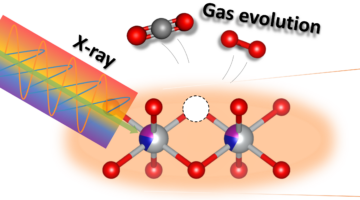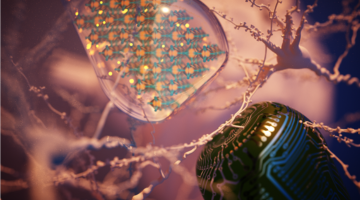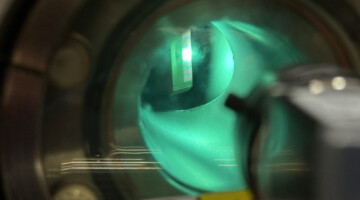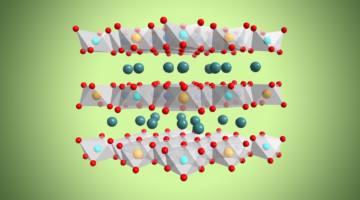Researchers used soft x-ray resonant inelastic x-ray scattering at the ALS to understand the role of aluminum doping in improving the stability of commercially used cathode materials for lithium-ion batteries. Read more »
ALS Work Using RIXS
Resonant inelastic x-ray scattering (RIXS) is a photon-in/photon-out spectroscopy where both the energy and momentum of the scattered photons could be measured. A full-energy-range mapping of RIXS (mRIXS) is collected by sweeping the incident x-ray photon energy across the absorption edge of interest, and the inelastically scattered photon energy is detected by a spectrometer. Critical RIXS features often correspond to various low-energy charge, spin, orbital, and lattice excitations. At the ALS, an iRIXS endstation has been developed for high-efficiency mRIXS experiments.
Mind-Blowing Materials: Mimicking Neurons for Faster Computing
Researchers used x-ray absorption spectroscopy and resonant inelastic x-ray scattering at the ALS to uncover the atomic-level mechanism of conductance switching for a neuromorphic material that has the potential for energy-efficient computing. Read more »
Manganese Cathodes Could Boost Lithium-ion Batteries
Rechargeable lithium-ion batteries are used in mobile devices, electric vehicles, and energy storage systems. But supplies of nickel and cobalt, commonly used in the cathodes of these batteries, are limited. New research opens up a potential low-cost, safe alternative in manganese, the fifth most abundant metal in the Earth’s crust. Read more »
Strategic ALS Projects Reach Key Milestones
Thanks to the hard work and dedication of multidisciplinary teams from groups across the ALS, a spate of important milestones occurred over the past month, for projects involving the new QERLIN beamline, the MERLIN beamline upgrade, and a new chamber for computer-chip metrology in Sector 12. Read more »
Cobalt or Nickel: Which is Better for High-Energy Battery Cathodes?
High-energy Li-ion batteries can provide both high capacity and high voltage, both of which are important in electric vehicles for greater range and faster acceleration. Here, researchers untangled the contributions of nickel and cobalt in high-energy Li-rich battery cathodes, pointing the way to optimizing them via a compositional approach. Read more »
Surface Engineering Boosts Water-Splitting Efficiency
Researchers modified the surface of an electrocatalyst to maximize its efficiency at splitting water. The optimized material is approximately 40 times more efficient than similar commercial electrocatalysts and could help make the production of clean hydrogen fuel more sustainable and economical. Read more »![]()
![]()
Jinghua Guo to Receive the 2022 Shirley Award
ALS senior scientist Jinghua Guo is the recipient of this year’s Shirley Award for Outstanding Scientific Achievement at the ALS. Guo is being recognized for pioneering the development of operando soft x-ray spectroscopy, work that’s enabled studies under realistic conditions, which is of great importance in environmental and energy research. Read more »
Copper Doping Improves Sodium-Ion Battery Performance
A big plus for batteries based on sodium over lithium is that sodium is more earth-abundant, which lowers costs and eases environmental and supply-chain concerns. Research to improve the performance of sodium-ion batteries includes this effort to use copper doping of the cathode to enhance oxygen redox reversibility. Read more »
How Iron Remediates Arsenic in Groundwater
Though iron has been demonstrated as an effective means to remediate arsenic contamination in groundwater, the mechanism was not well understood until now. For the first time, researchers have untangled the detailed steps of the interaction, informing more robust strategies for cleanup. Read more »
Trace Key Mechanistic Features of the Arsenite Sequestration Reaction with Nanoscale Zerovalent Iron
The advancing in situ XAS technique made it possible to uncover the As-nZVI reaction pathway, especially capturing transient reaction process at subsecond scale. Combining the in situ XAS experimental data with computational chemistry enabled the reaction steps to be verified, clarifying the unambiguous identification of the transit reactive intermediates. Read more »









